Throwing a Diamond Hitch
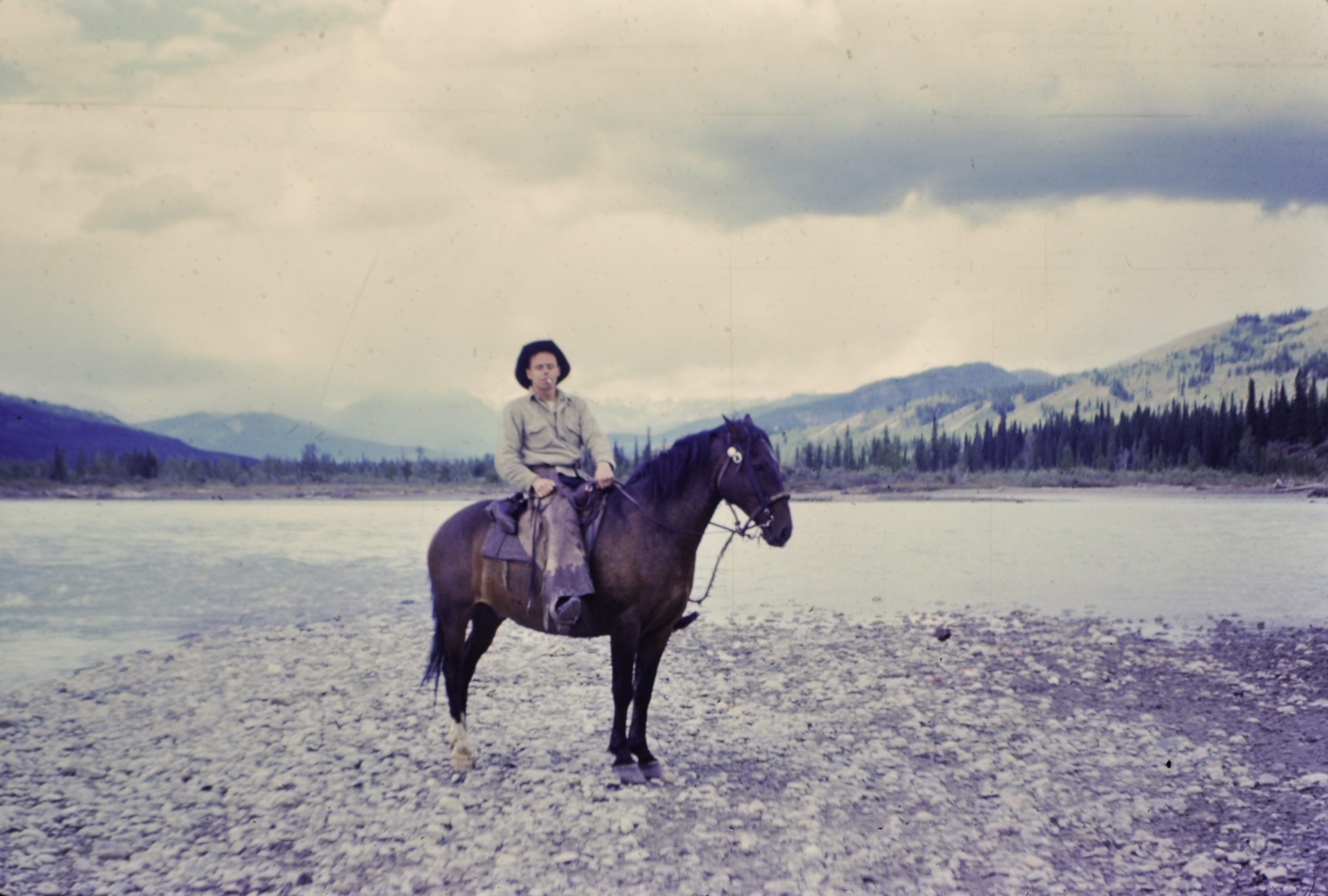
That is my Dad, Jim Mawdsley, in the foothills of Alberta, circa 1952. He would have been 22 and recently finished his BSc in geology. Throughout his life he often said, “This reminds me of working in the field,” then tilt his head up and to the right, focus on the middle-distance and reminisce as he spoke to no one in particular.
Judging by the number of times Dad brought up his fieldwork, it was clearly a special time for him. He would have loved living in the outdoors, surrounded by the beauty of the foothills, practicing his geological profession, travelling by horseback and being close to nature for extended periods. However, when I heard the words, “When I was working in the field” I often tuned out. It now appears that I ignored too much of what Dad said.
The ongoing repetition of the fieldwork topic was not at the top of the list of things that bothered me, as a boy, about my Dad. Although no such list existed (not a written one, anyway), it would have been long. I now wish – seven years after his passing – that I had paid more attention when he shared his memories. Maybe I could have known him better or learned something practical. He was a practical guy and loved his family very much.
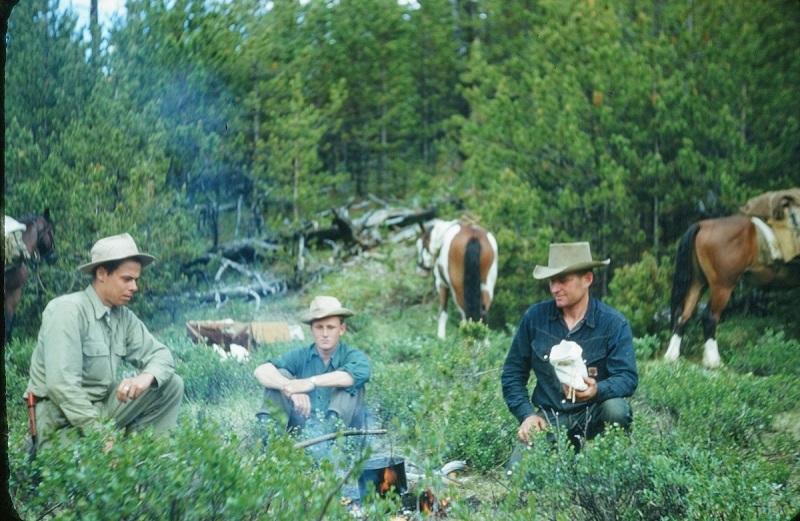
A few months ago, I was reminded of one of Dad’s favourite fieldwork stories, the topic of “throwing a diamond hitch”. The diamond hitch is a method of tying loads on packhorses. I imagined, for decades, a knot with a diamond shape (as the name implies) that allowed the rope to reach out in four or more directions to multiple anchor points. I pictured it with the size of a fist but have recently learned it isn’t a knot at all, but a broader fastening technique that reaches back and forth several times across large pieces of gear on the packhorse.
Horses provided ideal and reliable transportation for Dad’s long geological mountain trips because they could carry of large amounts of camping gear and return with many rock samples to be used for further study. Horses could do all this while covering rough and steep terrain and crossing rivers with rapidly-flowing water. Dad grew up around horses on the farm where he was raised in Eastern Alberta in the 1930s and 40s. He was very comfortable with horses and, as an animal lover, they were likely comfortable with him. Before the family could afford a tractor, horses were used as draft animals to pull farm implements and Dad also rode his horse to school.
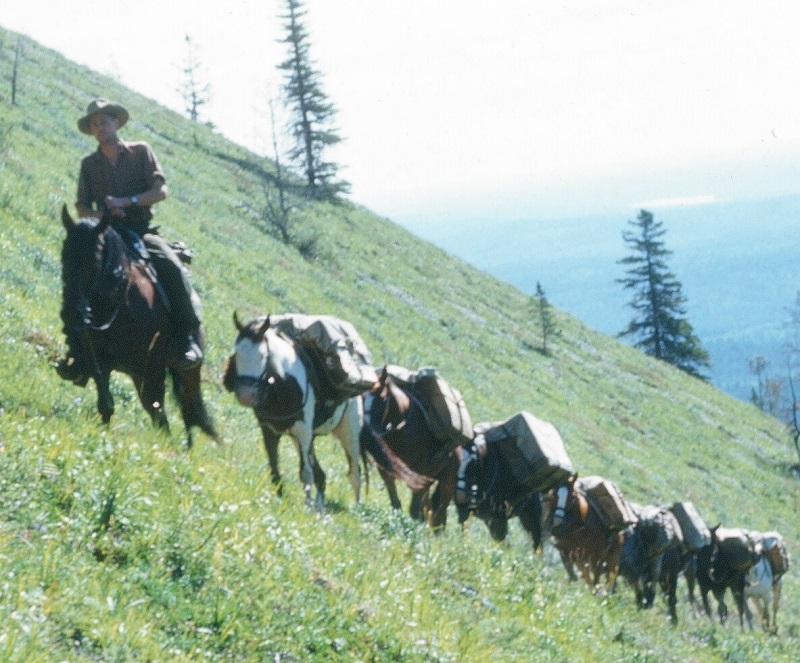
The diamond hitch topic usually came up when Dad was securing something on the roof of our car, for instance when the family was going on one of our many camping trips to the mountains. The massive and heavy canvas tent, the canoe or both would be fastened there. Instead of just, “This reminds me of when I was working in the field,” it expanded to include, “I learned how to throw a diamond hitch.” Apparently, one does not tie a diamond hitch, they throw it. This raised many questions for a curious boy (Throw? Throw where, exactly? At the horse? How far away is the horse? Why isn’t he closer? Is he dangerous? Why not get a friendly horse?) Even though I had my whole life ahead of me, I didn’t dare ask for clarification on these valid questions.

The first family car I remember was a white 1962 Pontiac Strato Chief, like the one shown in the picture below. We had roof rack which was connected to the top of the car on the ½ inch-wide rain channels that ran along the outside edges of the roof. Each “foot” of the rack sat in a channel and was held firmly in place by an integrated bracket that clamped to the underside of the channel. Dad tightened the bracket so tight that it was almost impossible to remove. It was a solid system, and the rack could hold significant weight.
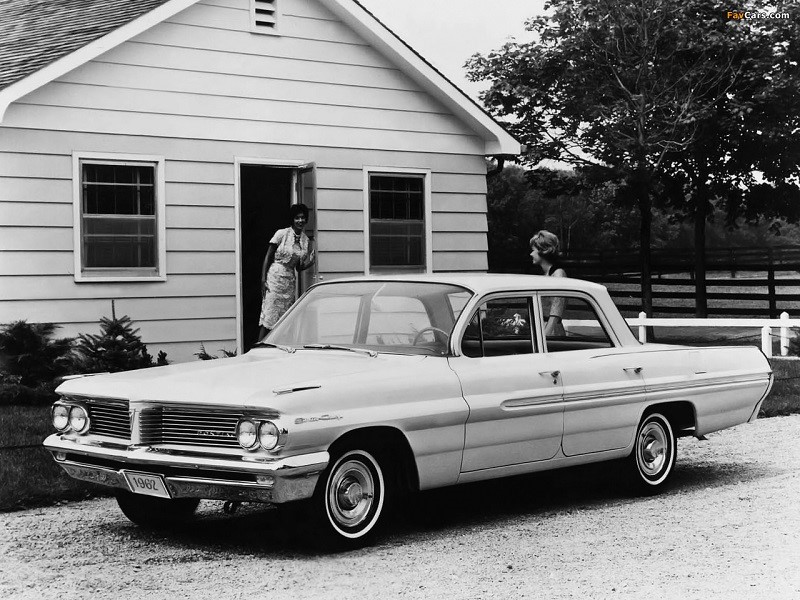
had an inline six-cylinder engine and a “three on the tree” manual transmission
Dad also used the roof rack to transport wood from the lumber store when buying materials for the fence, a shed, renovations or various other projects around the house. Mike, my older brother, and I were expected to join Dad even when we were too young to provide any help. Dad tied the lumber on the roof racks and, as he worked, we were again forced to listen to the diamond hitch story.
I don’t remember the exact details, but let’s assume we were five and seven. When first hearing the words, “fieldwork … blah, blah, blah … diamond hitch” Mike and I would glance at each other, cross our eyes, stick our tongues out the side of our mouths and try to fart. If one of us succeeded we would erupt in out-of-control giggles, causing us to fall against the car and then to the pavement. Dad looked down at us rolling on the ground and yell that we were being disrespectful (true), having it too easy compared to him (very true) and we should smarten up (also true). The reader will have heard – or spoken – these honest words because they have been voiced for generations, in dozens of languages and continue to be expressed today.
Once the lumber was fastened we drove towards home, but stop after a few blocks to make sure all was secure. It always was. Dad tethered things so firmly that they would never move and if you plucked at the rope, it would probably hum at the pitch of a bass guitar’s open E-string.
I can imagine what might have happened if Dad had to swerve sharply at high speed to avoid a deer running across road. The car would spin out of control and the weight of the lumber would initiate a roll of multiple times into the ditch. I picture this fictional scene transpiring:
The car would be upside down with the tires spinning slowly and steam rising from the damaged radiator. I would be lying facedown in the ditch (this was before seatbelts were required) with my left arm broken and folded behind my back from a dislocated shoulder. Painfully turning my head, I could see Dad a few feet away on his back with blood flowing down the side of his face. Shards of glass were imbedded in his forehead from when he was thrown through the windshield.
Dad looked over and said, “John! Are you okay?”
“No! I think my arm is broken. I can’t move it!”
With relief (that I was conscious, one supposes) Dad said, “Oh good, you are probably fine. Just toughen up, Mom will give you a Band-Aid when we get home.”
The reader probably wants to know what happened to the lumber since it is obviously the main protagonist in this little story-within-a-story. I will get to that, but first let’s check in with Mike.
Dad would say, “Shit, where is Mike!?”
“He was wearing his seatbelt; he’s still in the car.”
I knew this because I saw Mike in the front passenger seat, safely secured by his seatbelt, as I flew past him from my place in the back seat. Mike was in the front seat because he is the older brother and that is the natural hierarchy of sibling-car-seat-occupancy. Mike, the common-sensed one, always wore the optional seatbelt.
Anyone who has experienced a dangerous situation like this (especially a fictional one) will know that things happen in slow motion. Given this, as I floated past, I had time to address Mike, “It appears you weren’t such a ‘stoopid poo-poo-pants dummie-face’ after all.” [In my defence, remember I was five.] For clarity, I continued, “You were very smart for wearing your seatbelt and I now wish I had worn one. I apologize for the unfair and harsh characterization.”
Mike replied, “Told you so, told you so … nanah-nanah-na-nahhh! Good luck landing in the ditch, nincompoop!”
I tried to come up with a witty comeback but failed. I did have time, though, to stick my tongue out at Mike before exiting through the windscreen area, immediately after Dad had breached the glass.
From where Dad came to rest in the ditch, he lifted his head to see Mike hanging upside down from his seatbelt and struggling to disconnect himself. Dad said, “Okay, you boys are fine, and we will need a new car, however, it could have been worse.”
With an ironical, yet disrespectful, tone I said. “How is that so, father?”
Dad flashed an angry glance and said, “The lumber looks fine.”
The lumber was about 30 feet beyond, torn from the car but undamaged, resting upright and still firmly moored to the roof racks. The racks, in turn, were attached to pieces of twisted-metal that had been ripped from the roof, like lids from opened tuna cans. A quiet hum could be heard, similar to a slightly out-of-tune bass guitar.
Dad slowly lifted himself to his feet, looked (unconcerned) at the blood on the sleeve where he had wiped his face and said, “This reminds me of when I was working in the field and threw the strongest diamond hitch ever.”
I coughed and wept, “Oh please God, just take me now.”
Angry again, he said “What did you say? You little brat!”

Thinking fast, I came up with, “Oh geez Dad, just tell me how!”
Dad lowered an eyebrow, looked at me suspiciously, but then continued, “On a river crossing an old gelding lost its footing and fell over in the rapid current, but that amazing diamond hitch held everything together. In fact, it probably saved the horse’s life. Downstream, that darned ol’ packhorse eventually gained its footing and walked out of the river with everything secure. We didn’t lose a single rock sample, camp pot or even one bean of coffee. We continued on our way like nothing happened.”
I moaned in pain.
Not physical pain from the broken arm, but emotional pain from hearing yet another unrelatable story of “working in the field” and the damned diamond hitch.
Despite our resistance to take his advice on many topics, Dad did manage to teach Mike and I several things, including how to fasten loads with rope. As a result, I have never had any problems when tying things on vehicles over the years. To be honest, I kind of enjoy the process and take pride in knowing the load will not move. Mike and I recently secured the old canoe on the roof of his car, and we fiddled with it for over an hour to make sure it was solid and safe. Dad would have been proud, however, Mike’s wife, Margo, teased us after we finally finished the project, “I thought you were loading a canoe, not building one.”

with the same canoe that is still in the family
What Dad taught is a method I have used for decades. I choose from the many ropes always on hand and, depending on the load, use one of 20 or 30 feet in length. I start with a loop (using a bowline knot) around the right-side of the rear rack then throw it over the load to the left-side, pull to tighten, a couple securing wraps around the rack then throw it across-and-forward to the right-side of front rack, tighten and wrap, throw it back across the load to the left-side of the front rack, again tighten and wrap and then throw it across-and-back to where I began on the right-side of the rear rack. A few quick wraps and overhand knots to finish this first stage.
The second stage is key, so stick with me and try to imagine. I take the rope’s loose end which, if I planned correctly, will be about five to 10 feet long and secure it to the middle of the rope’s section that earlier had crossed the load parallel to the rear rack. From there, I throw the rope forward (along the center of the load) and then around the middle of the section that crosses parallel to the front rack. Now, pulling rearwards on the remaining loose end applies mechanical advantage to those two parallel sections, drawing them towards each other and making them both very tight. Finally, a few more overhand knots and the load is secure.
The alert reader might say, “John, that kinda makes a shape of a diamond across the top of the load, doesn’t it? Also, you used the word ‘throw’ five times!” I ask this reader to not get ahead of my story, but I appreciate the observations.
Last fall, shortly after I turned 63, the diamond hitch was – for the first time in many years – brought to my attention. I was re-reading Sid Marty’s 1978 book, Men for the Mountains, which I initially read in my twenties. It is about the early days of wardens working in Canada’s National Parks who regularly travelled by horseback and carried their gear on packhorses. Mr. Marty also spoke of “throwing a diamond hitch” and provided a good written description. However, I couldn’t visualize it, so I grabbed my iPhone and searched “diamond hitch.”
What I saw were the first images I had ever seen of the technique, one of these is shown below.
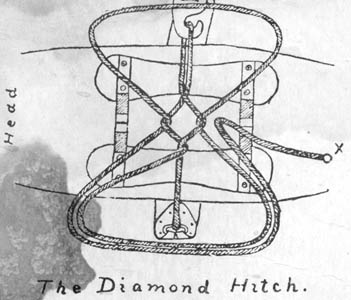
photo credit: Marcool04 CC BY-SA 3.0
Staring at the sketch above, with my mouth hanging open, I said quietly, “Shit! Dad tried to teach me how to ‘throw a diamond hitch!’”
Without knowing it, I had been “throwing” an elementary form of the diamond hitch for decades. Not a proper diamond hitch, but Dad’s instruction had provided me with an excellent technique for securing loads. Maybe if I hadn’t tuned him out, I could have perfected a true diamond hitch.
Interestingly, our daughter and I were picking up a load of lumber last summer and I provided a lesson on my fastening method (before I learned the correct diamond hitch technique). Fortunately for me, she did not tune me out, asked many questions and allowed me share knowledge I gained from her Grandpa Jim.
Dad passed away in 2015 and Mom in 2016. I miss them both very much and wish I could go back in time to when Dad last brought up the diamond hitch. Wouldn’t it be amazing if it were possible to rewind his life’s tape to find that point and re-record? I could ask questions, listen carefully, ask him to demonstrate and practice with me, and treat his hard-earned experience with more respect.
At this point, I should conclude with a concise, subtle and profound statement to leave readers with something to ponder and apply in life. I could hint at: appreciate your parents while they are alive, or forgive their many human faults, or consider that they actually have something to contribute, or ask yourself, “What else can I learn from my parents?”
Alternatively I might address those who, in addition to having parents, are parents themselves. For them, I could suggest: try to be more patient, or less quick to anger, or relax and the kids will figure it out for themselves, or consider hiring a professional to deliver the lumber.
However, I won’t attempt such a strong finish and will simply end the story with another picture of Jim Mawdsley, this one was taken at an ideal lunch spot on a perfect summer day.
Clearly, one of the many happy experiences Dad had while “working in the field.”
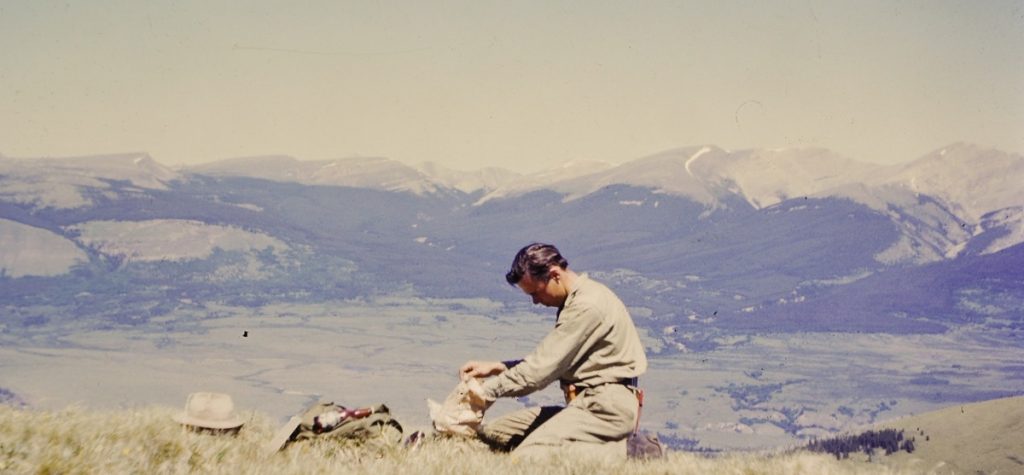

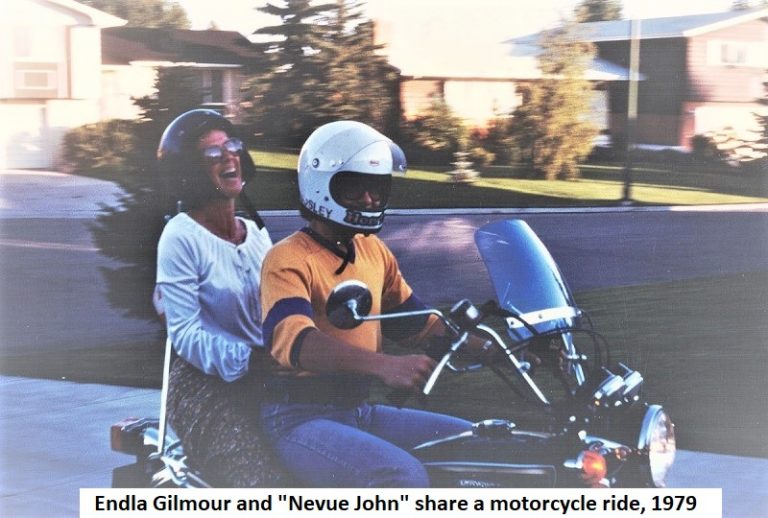

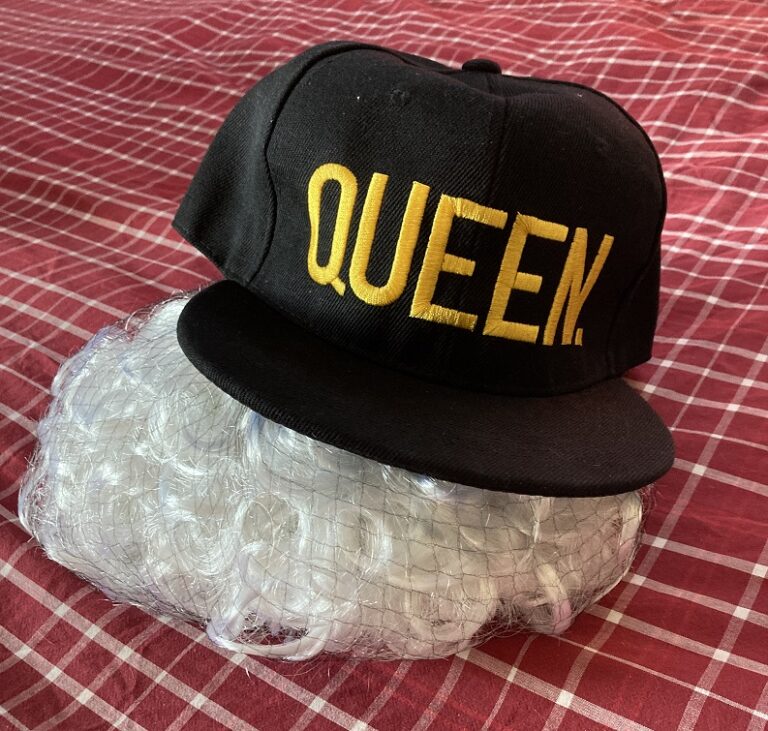


This is beautiful, John. Thank you. You look just like your dad!
Thanks Laura,
I very much appreciate your support of my writing!
John
John, this is priceless! So funny! So well written ! The dear photos are the best. So many years ago, not you —— him ! You must count yourself ahead of me – – – in ‘resilience’ over these years.
This reminds me of course, of the camping hike we took , you were gone from home by then (maybe driving Brewster Buses up and down the Sun Shine Ski Resort hill, making tourists riding on your bus, chuckle) when your Dad, who hated games, took his turn at Charades beside the rapidly flowing river coming down from Twin Falls (our campsite for the night). Jim was hilarious, silently beside the roaring waters acting out the A and W Root Beer Bear ! Trying to get his team to guess – – what he was trying to show us. Bless him, so relaxed in his spiritual woodlands home, that he could have such fun in causing us all to be rockin’ with laughter, bewildered and clueless as to be able to guess what the words were that he was so cleverly acting out. Love us all with our strengths and and slightly less – – – for our foibles.
Florence
I really enjoyed this story about your dad! Thanks for sharing it.
Thanks Katherine, glad you liked it.
Have a great weekend!